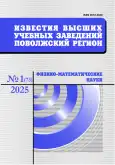On a strict mathematical definition of the brachistochrone’s shape taking into account the thermal effect in the contact zone
- Authors: Gladkov S.O.1, Bogdanova S.B.1
-
Affiliations:
- Moscow Aviation Institute (National Research University)
- Issue: No 1 (2025)
- Pages: 29-44
- Section: MATHEMATICS
- URL: https://journals.rcsi.science/2072-3040/article/view/297177
- DOI: https://doi.org/10.21685/2072-3040-2025-1-3
- ID: 297177
Cite item
Full Text
Abstract
Background. Current research on the properties of brachistochrones as lines with extreme properties indicates that this work is relevant because it takes into account for the first time the influence of thermal effects on the shape of the brachistochrone. The purpose of the study is an analytically rigorous solution to the problem. Matherials and methods. The main method for solving the problem is the moving basis method, which has proven itself well in solving many problems related to the study of various properties of brachistochrones. Results. A rigorous analytical solution of the formulated problem is given, taking into account the thermal effect, which was taken into account by introducing a dissipative function. Conclusions. Thanks to the algorithm proposed in the article, a general methodological approach has been formulated that is useful in solving such problems related to taking into account the thermal properties of materials.
About the authors
Sergey O. Gladkov
Moscow Aviation Institute (National Research University)
Author for correspondence.
Email: sglad51@mail.ru
Doctor of physical and mathematical sciences, professor, professor of the sub-department No.311 of applied software and mathematical methods
(4 Volokolamskoye highway, Moscow, Russia)Sofya B. Bogdanova
Moscow Aviation Institute (National Research University)
Email: sonjaf@list.ru
Candidate of physical and mathematical sciences, associate professor, associate professor of the sub-department No.311 of applied software and mathematical methods
(4 Volokolamskoe highway, Moscow, Russia)References
- Elsgolts L.E. Differentsialnyye uravneniya i variatsionnoye ischisleniye = Differential equations and calculus of variations. Moscow: Nauka, 1969:424. (In Russ.)
- Yang L. Lektsii po variatsionnomu ischisleniyu i teorii optimalnogo upravleniya = Lectures on the calculus of variations and optimal control theory. Moscow: Mir, 1974:488. (In Russ.)
- Gladkov S.O. On the trajectory of a body entering a liquid at an arbitrary angle. Uchenyye zapiski fizicheskogo fakulteta MGU = Proceedings of the faculty of physics of MSU. 2016;(4):164002-1–164002-5. (In Russ.)
- Lipp S.C. Brachistochrone with Coulomb friction. SIAM J. Control Optim. 1997;35(2):562–584.
- Hayen J.C. Brachistochrone with Coulomb friction. Int. J. Non-Linear Mech. 2005;40(8):1057–1075.
- Gladkov S.O., Bogdanova S.B. General dynamic equations of plane axial motion of a material body along a duct taking into account the strength of the friction (their numerical analysis in some frequent cases). Uchenyye zapiski fizicheskogo fakulteta MGU = Proceedings of the faculty of physics of MSU. 2017;(1):171101-1–171101-5. (In Russ.)
- Ashby N., Brittin W.E., Love W.F., Wyss W. Brachistochrone with Coulomb friction. Am. J. Phys. 1975;43:902–905.
- Gelfad I.M., Fomin S.V. Variatsionnoye ischisleniye = Calculus of variations. Moscow: Fizmatgiz, 1961:284. (In Russ.)
- Gladkov S.O., Bogdanova S.B. Geometric phase transition in the brachistochrone problem. Uchenyye zapiski fizicheskogo fakulteta MGU = Proceedings of the faculty of physics of MSU. 2016;(1):161101-1–1611015. (In Russ.)
- Gladkov S.O., Bogdanova S.B. Analytical and numerical solution of the problem on brachistochrones in some general cases. Journal of Mathematical Sciences. 2020;245(4):528–537.
- Gladkov S.O., Bogdanova S.B. On a class of planar geometrical curves with constant reaction forces acting on particles moving along them. Journal of Mathematical Sciences. 2021;257(1):27–30. (In Russ.)
- Gladkov S.O., Bogdanova S.B. On the influence of the Magnus effect on the shape of the brachistochrone. Vestnik Tomskogo gosudarstvennogo universiteta = Bulletin of Tomsk State University. 2023;(84):33–39. (In Russ.)
- Gladkov S.O. On one methodical approach to deriving basic physical equations. Fizicheskoye obrazovaniye v vuzakh = Physics education in universities. 2021;27(2):5–11. (In Russ.)
- Gladkov S.O. To the question of calculating the time of stopping the internal organs in the vertical continuum of the tibial body and the time of movement of the external tibial organ aligned with it. Zhurnal tekhnicheskoy fiziki = Journal of Technical Physics. 2018;88(3):337–341. (In Russ.)
- Gladkov S.O. On the issue of self-organization of processes of change in the population of the Earth. Biofizika = Biophysics. 2021;66(5):1005–1014. (In Russ.)
- Boltyanskiy V.G. Matematicheskiye metody optimalnogo upravleniya = Mathematical methods of optimal control. Moscow: Nauka, 1969:408. (In Russ.)
Supplementary files


























